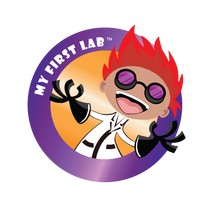
My First Microscope Guide
My First Microscope Guide
Microscopes are an amazing tool that reveals a completely unseen world. However, these devices can be tricky for first time users. At My First Lab, we are here to provide a go-to guide into the world of microscopy- and all the fun discoveries it holds. For the purposes of this guide, we will be using the MFL-06 Duo Scope as a visual reference point. This scope has all the same features of a professional scope while having a kid-friendly design. Let’s dive in!
The Anatomy of a Microscope
- The Eyepiece: This is where you investigate your microscope. A small lens is positioned here to provide initial magnification. In the Duo Scope, this is a 10x – or, what the object would look like if you were ten times closer to it.
- Nosepiece: This is what holds the objectives, and allows the user to spin them to the desired magnification, which brings us to…
- Objectives: These stems are what help you to increase the magnification of the slide even further. Most microscopes come with three different magnifications of varying intensities, but some professional scopes have more. For the Duo Scope, we have 4x, 10x and 40x objectives.
- Stage: This is where you place your slides, positioned over the small hole in the middle. When the light passes through the hole, it illuminates the specimen, allowing the user to see clear details.
- Stage Clips: Slides like to move around, so these clips help to hold them in place once you find the exact view you want to explore.
- Diaphragm: This dial helps you control the amount of light passing through to the specimen. It also helps to provide contrast.
- Bottom Light: This is what helps provide clarity to each slide. The light passes up through the scope and through the slide itself.
- Adjustment Knobs: This will move the stage closer or farther away from the objective, allowing the user to bring the specimens into focus.
- Light Switch: Turns on the base light. In the case of our Duo Scope, it also can turn on the upper light so users can view 3D objects.
- Bonus Feature: Upper lighting allows for the user to position 3D objects and large samples on the stage. This is perfect for observing items like geodes and bugs. This is also a feature found in Stereo Microscopes.
Positioning a Slide Sample
Now that the anatomy of a scope is laid out, let us try viewing some specimens. Prepared Slides are an excellent way for beginners to get familiar with their microscopes and focusing specimens.
- The specimen is usually laid out in the middle of the slide, so align that with the hole in the center of the microscope stage.
- Turn on the microscope light and look through the eyepiece.
- If the image seems fuzzy, turn the adjustment knobs towards you or away from you until slide details begin to sharpen.
- If the specimen seems off-center, very gently shift the slide with your fingers in the appropriate direction. Once the specimen is centered, move the stage clips onto the ends to hold the slide in place.
- Adjust the focus as needed until you see the specimen in full detail.
The Care and Keeping of Scopes
Microscopes designed for kids usually have durable construction, but there are some other things to keep in mind when caring for a microscope.
- Use lens paper to clean the microscope lens and clean it often. The gentle paper will keep the glass dust and scratch-free.
- Always begin to focus on the lowest objective, and then move up from there.
- Always turn off the microscope lights when not in use.
- When storing the microscope, remove any slides from the base and return the objectives to the lowest setting. If your microscope model has a chord, carefully wrap it around the base.
- Always position the microscope upright when at rest.
- To help keep the microscope clean and dust-free, you can also buy a cover or case for it.
The more explorers practice with their microscope, the less tricky it will become. Each microscope might have its own extra features, but the controls remain familiar. Whether using a standard biology scope, a kid scope, a stereo scope or anything in between, there are dozens of ways to explore the microscopic world.
Want to learn more?
